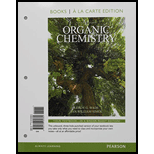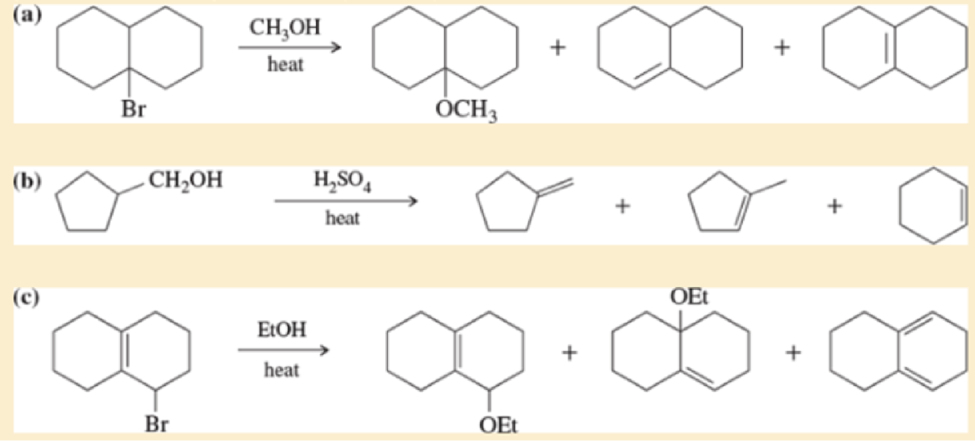
Organic Chemistry, Books a la Carte Edition (9th Edition)
9th Edition
ISBN: 9780134160382
Author: Leroy G. Wade, Jan W. Simek
Publisher: PEARSON
expand_more
expand_more
format_list_bulleted
Concept explainers
Textbook Question
Chapter 7, Problem 7.61SP
Propose mechanisms for the following reactions. Additional products may be formed but your mechanism only needs to explain the products shown

Expert Solution & Answer
Want to see the full answer?
Check out a sample textbook solution
Students have asked these similar questions
Using reaction free energy to predict equilibrium composition
Consider the following equilibrium:
2NO2 (g) = N2O4(g)
AGº = -5.4 kJ
Now suppose a reaction vessel is filled with 4.53 atm of dinitrogen tetroxide (N2O4) at 279. °C. Answer the following questions about this system:
Under these conditions, will the pressure of N2O4 tend to rise or fall?
Is it possible to reverse this tendency by adding NO2?
In other words, if you said the pressure of N2O4 will tend to rise, can that
be changed to a tendency to fall by adding NO2? Similarly, if you said the
pressure of N2O4 will tend to fall, can that be changed to a tendency to
'2'
rise by adding NO2?
If you said the tendency can be reversed in the second question, calculate
the minimum pressure of NO 2 needed to reverse it.
Round your answer to 2 significant digits.
00
rise
☐ x10
fall
yes
no
☐ atm
G
Ar
1
Why do we analyse salt?
Curved arrows are used to illustrate the flow of electrons. Using
the provided starting and product structures, draw the curved
electron-pushing arrows for the following reaction or
mechanistic step(s).
Be sure to account for all bond-breaking and bond-making
steps.
H
H
CH3OH, H+
H
Select to Add Arrows
H°
0:0
'H
+
Q
HH
■ Select to Add Arrows
CH3OH,
H*
H.
H
CH3OH, H+
HH
■ Select to Add Arrows i
Please select a drawing or reagent from the question area
Chapter 7 Solutions
Organic Chemistry, Books a la Carte Edition (9th Edition)
Ch. 7.3A - Prob. 7.1PCh. 7.3A - Prob. 7.2PCh. 7.3B - Draw five more compounds of formula C4H6NOC1.Ch. 7.3B - For each of the following molecular formulas,...Ch. 7.4 - Give the systematic (IUPAC) names of the following...Ch. 7.5B - The following names are all incorrect. Draw the...Ch. 7.5B - Prob. 7.8PCh. 7.5B - a. How many stereogcmc double bonds are in...Ch. 7.6 - Teflon-coated frying pans routinely endure...Ch. 7.7B - Prob. 7.11P
Ch. 7.8B - Use the data in Table7-2 to predict the energy...Ch. 7.8C - Prob. 7.13PCh. 7.8E - Explain why each of the following alkenes is...Ch. 7.8F - Prob. 7.15PCh. 7.10 - Prob. 7.16PCh. 7.10A - SN1 substitution and E1 elimination frequently...Ch. 7.10C - Prob. 7.18PCh. 7.10C - Prob. 7.19PCh. 7.10C - Prob. 7.20PCh. 7.11 - Prob. 7.21PCh. 7.11 - Prob. 7.22PCh. 7.12 - Prob. 7.23PCh. 7.12 - Prob. 7.24PCh. 7.13 - Prob. 7.25PCh. 7.14B - Prob. 7.26PCh. 7.14B - Make models of the blowing compounds, and predict...Ch. 7.15 - Prob. 7.28PCh. 7.15 - Prob. 7.29PCh. 7.15 - Prob. 7.30PCh. 7.15 - Prob. 7.31PCh. 7.16 - Predict the major and minor elimination products...Ch. 7.17B - Predict the products and mechanisms of the...Ch. 7.18 - Propose mechanisms for the following reactions.Ch. 7.18 - Prob. 7.35PCh. 7.19B - The dehydrogenation of butane to trans-but-2-ene...Ch. 7.19B - Prob. 7.37PCh. 7.19B - Prob. 7.38PCh. 7.19B - Prob. 7.39PCh. 7 - Prob. 7.40SPCh. 7 - Prob. 7.41SPCh. 7 - Prob. 7.42SPCh. 7 - Prob. 7.43SPCh. 7 - Prob. 7.44SPCh. 7 - Prob. 7.45SPCh. 7 - Prob. 7.46SPCh. 7 - The energy difference between cis- and...Ch. 7 - Prob. 7.48SPCh. 7 - Prob. 7.49SPCh. 7 - Prob. 7.50SPCh. 7 - What halides would undergo E2 dehydrohalogenation...Ch. 7 - Prob. 7.52SPCh. 7 - Prob. 7.53SPCh. 7 - Write a balanced equation for each reaction,...Ch. 7 - Prob. 7.55SPCh. 7 - Using cyclohexane as your starting material, show...Ch. 7 - Show how you would prepare cyclopentene from each...Ch. 7 - Prob. 7.58SPCh. 7 - E1 eliminations of alkyl halides are rarely useful...Ch. 7 - Prob. 7.60SPCh. 7 - Propose mechanisms for the following reactions....Ch. 7 - Prob. 7.62SPCh. 7 - Prob. 7.63SPCh. 7 - Prob. 7.64SPCh. 7 - Prob. 7.65SPCh. 7 - Prob. 7.66SPCh. 7 - Prob. 7.67SPCh. 7 - Prob. 7.68SPCh. 7 - Prob. 7.69SPCh. 7 - Explain the dramatic difference in rotational...Ch. 7 - One of the following dichloronorbornanes undergoes...Ch. 7 - A graduate student wanted to make...Ch. 7 - Prob. 7.73SPCh. 7 - Prob. 7.74SPCh. 7 - Prob. 7.75SPCh. 7 - Prob. 7.76SP
Additional Science Textbook Solutions
Find more solutions based on key concepts
Identify me theme or themes exemplified by (a) the sharp quills of a porcupine (b) the development of a multice...
Campbell Biology in Focus (2nd Edition)
Give the IUPAC name for each compound.
Organic Chemistry
Label each statement about the polynucleotide ATGGCG as true or false. The polynucleotide has six nucleotides. ...
General, Organic, and Biological Chemistry - 4th edition
Why are mutants used as test organisms in the Ames test?
Laboratory Experiments in Microbiology (12th Edition) (What's New in Microbiology)
Some people compare DNA to a blueprint stored in the office of a construction company. Explain how this analogy...
Biology: Concepts and Investigations
Knowledge Booster
Learn more about
Need a deep-dive on the concept behind this application? Look no further. Learn more about this topic, chemistry and related others by exploring similar questions and additional content below.Similar questions
- What are examples of analytical methods that can be used to analyse salt in tomato sauce?arrow_forwardA common alkene starting material is shown below. Predict the major product for each reaction. Use a dash or wedge bond to indicate the relative stereochemistry of substituents on asymmetric centers, where applicable. Ignore any inorganic byproducts H Šali OH H OH Select to Edit Select to Draw 1. BH3-THF 1. Hg(OAc)2, H2O =U= 2. H2O2, NaOH 2. NaBH4, NaOH + Please select a drawing or reagent from the question areaarrow_forwardWhat is the MOHR titration & AOAC method? What is it and how does it work? How can it be used to quantify salt in a sample?arrow_forward
- Predict the major products of this reaction. Cl₂ hv ? Draw only the major product or products in the drawing area below. If there's more than one major product, you can draw them in any arrangement you like. Be sure you use wedge and dash bonds if necessary, for example to distinguish between major products with different stereochemistry. If there will be no products because there will be no significant reaction, just check the box under the drawing area and leave it blank. Note for advanced students: you can ignore any products of repeated addition. Explanation Check Click and drag to start drawing a structure. 80 10 m 2025 McGraw Hill LLC. All Rights Reserved. Terms of Use | Privacy Center | Accessibility DII A F1 F2 F3 F4 F5 F6 F7 F8 EO F11arrow_forwardGiven a system with an anodic overpotential, the variation of η as a function of current density- at low fields is linear.- at higher fields, it follows Tafel's law.Calculate the range of current densities for which the overpotential has the same value when calculated for both cases (the maximum relative difference will be 5%, compared to the behavior for higher fields).arrow_forwardUsing reaction free energy to predict equilibrium composition Consider the following equilibrium: N2 (g) + 3H2 (g) = 2NH3 (g) AGº = -34. KJ Now suppose a reaction vessel is filled with 8.06 atm of nitrogen (N2) and 2.58 atm of ammonia (NH3) at 106. °C. Answer the following questions about this system: rise Under these conditions, will the pressure of N2 tend to rise or fall? ☐ x10 fall Is it possible to reverse this tendency by adding H₂? In other words, if you said the pressure of N2 will tend to rise, can that be changed to a tendency to fall by adding H2? Similarly, if you said the pressure of N will tend to fall, can that be changed to a tendency to rise by adding H₂? If you said the tendency can be reversed in the second question, calculate the minimum pressure of H₂ needed to reverse it. Round your answer to 2 significant digits. yes no ☐ atm Х ด ? olo 18 Ararrow_forward
- Four liters of an aqueous solution containing 6.98 mg of acetic acid were prepared. At 25°C, the measured conductivity was 5.89x10-3 mS cm-1. Calculate the degree of dissociation of the acid and its ionization constant.Molecular weights: O (15.999), C (12.011), H (1.008).Limiting molar ionic conductivities (λ+0 and λ-0) of Ac-(aq) and H+(aq): 40.9 and 349.8 S cm-2 mol-1.arrow_forwardDetermine the change in Gibbs energy, entropy, and enthalpy at 25°C for the battery from which the data in the table were obtained.T (°C) 15 20 25 30 35Eo (mV) 227.13 224.38 221.87 219.37 216.59Data: n = 1, F = 96485 C mol–1arrow_forwardIndicate the correct options.1. The units of the transport number are Siemens per mole.2. The Siemens and the ohm are not equivalent.3. The Van't Hoff factor is dimensionless.4. Molar conductivity does not depend on the electrolyte concentration.arrow_forward
- Ideally nonpolarizable electrodes can1. participate as reducers in reactions.2. be formed only with hydrogen.3. participate as oxidizers in reactions.4. form open and closed electrochemical systems.arrow_forwardIndicate the options for an electrified interface:1. Temperature has no influence on it.2. Not all theories that describe it include a well-defined electrical double layer.3. Under favorable conditions, its differential capacitance can be determined with the help of experimental measurements.4. A component with high electronic conductivity is involved in its formation.arrow_forwardTo describe the structure of the interface, there are theories or models that can be distinguished by:1. calculation of the charge density.2. distribution of ions in the solution.3. experimentally measured potential difference.4. external Helmoltz plane.arrow_forward
arrow_back_ios
SEE MORE QUESTIONS
arrow_forward_ios
Recommended textbooks for you

 Organic ChemistryChemistryISBN:9781305580350Author:William H. Brown, Brent L. Iverson, Eric Anslyn, Christopher S. FootePublisher:Cengage Learning
Organic ChemistryChemistryISBN:9781305580350Author:William H. Brown, Brent L. Iverson, Eric Anslyn, Christopher S. FootePublisher:Cengage Learning


Organic Chemistry
Chemistry
ISBN:9781305580350
Author:William H. Brown, Brent L. Iverson, Eric Anslyn, Christopher S. Foote
Publisher:Cengage Learning
Coenzymes and cofactors; Author: CH15 SWAYAM Prabha IIT Madras;https://www.youtube.com/watch?v=bubY2Nm7hVM;License: Standard YouTube License, CC-BY
Aromaticity and Huckel's Rule; Author: Professor Dave Explains;https://www.youtube.com/watch?v=7-BguH4_WBQ;License: Standard Youtube License